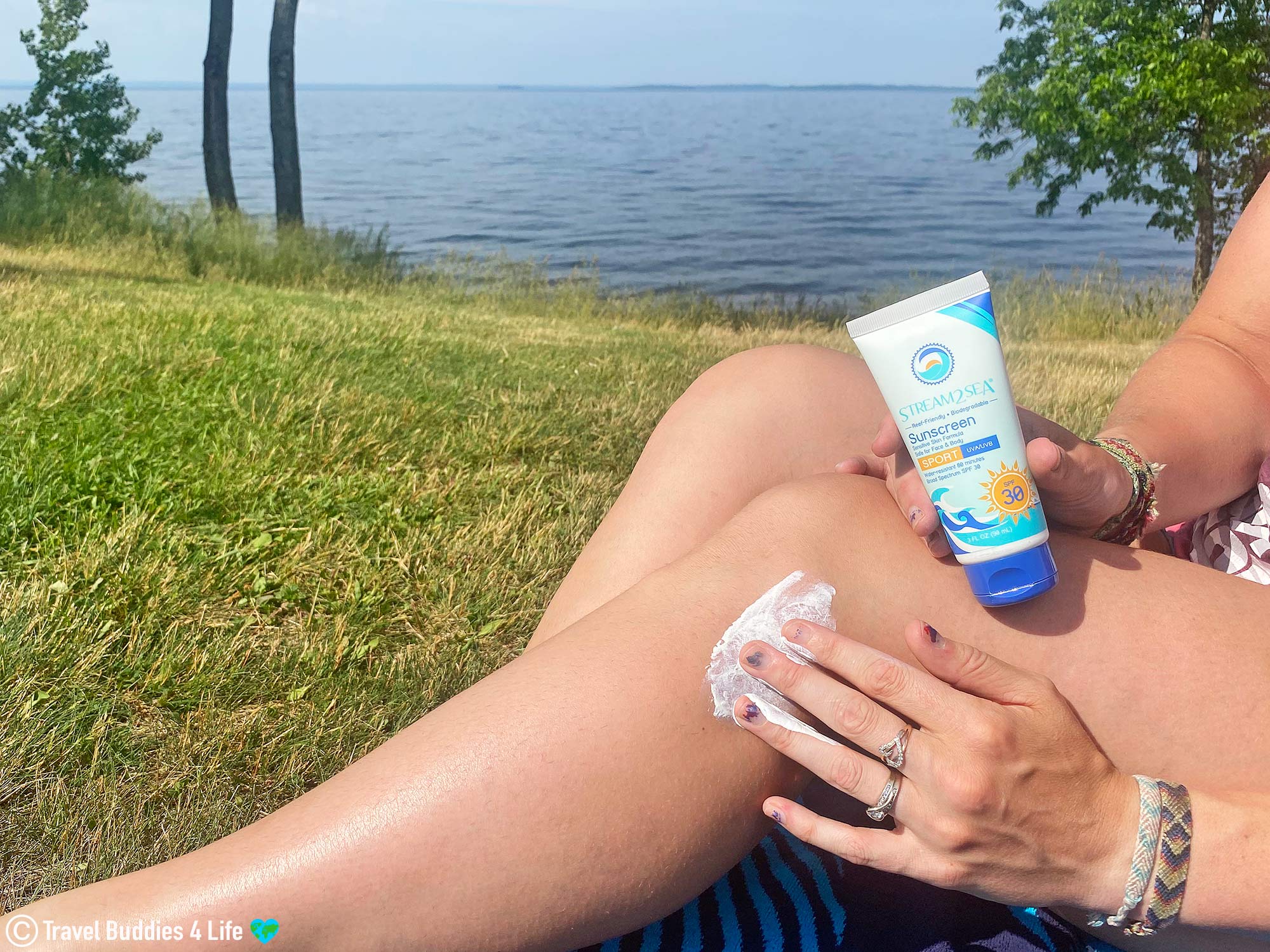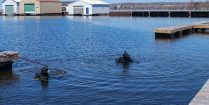I scream, you scream, we all scream for sunscreen.
The sun is shining; it’s a hot summer day, the UV index is through the roof. Wearing sunscreen is extremely important to protect your skin. But did you know that certain sunscreens cause damage to our planet’s reefs and wetlands?

In the heat of summer, or while on vacation, you slop on the sunscreen to avoid getting burned. That in and of itself is all fine and dandy; the problem arises when we head into the water and cool off.
It is estimated that 14 000 tons of sunscreen wash off beachgoers, divers, and snorkelers every year. When sunscreen washes off our skin, the chemicals mix with water and disperses affecting everything it comes into contact with.
Many synthetic sunscreens contain oxybenzone (BP-3 & BP-2) and octinoxate, which are used to filter UV light. The problem is, these particular synthetic chemicals are toxic to our lakes, rivers, and oceans.

Many different things in aquatic environments are affected by the chemicals in sunscreen. Take a look at some of the most influenced critters:
Coral reefs are one of the most valuable ecosystems on earth. As if they don’t face enough threats from climate change, invasive species, overfishing, and land development, that we need to add sunscreen pollution to the mix.
A 2016 study showed that when the harmful chemical components of sunscreen, oxybenzone, and octinoxate, get into the ocean, they increase a coral’s susceptibility to bleaching, damage DNA, cause abnormal skeletal growth and create deformities in larval stage coral.
Certain sunscreens have proven to be such a problem for corals, that in some places, such as Hawaii, they have gone as far as banning sales and use of sunscreens containing oxybenzone and octinoxate.

Not only are corals reacting to the problematic chemical in sunscreen, but so are fish. There has been a substantial gender shift in which male fish take on female attributes. Females have also had reproductive issues with reduced egg production and embryo hatchings.

The chemical compounds in sunscreen can affect even the smallest forms of life. Green algae can have their growth and ability to photosynthesis impaired by the presence of oxybenzone and octinoxate in the water column.
The chemicals present in sunscreen can be accumulated in the tissue of a dolphin and transferred to their young. Studies have also shown that oxybenzone can be transferred by both dolphin and human mothers to infants via breastmilk.
Your skin is important, and you SHOULD protect it. Here are a few things to consider when heading out into the sun and buying environmentally friendly sunscreen. They will help you make the smart choice for our planet’s future:
Covering your skin is one of our favorite ways to protect the environment. When heading out in the sun, cover your body with a hat, sunglasses, rashguard… No chemicals at all are better than even reef-safe mineral sunscreen. If you are covering up your body, apply sunscreen only to the important and exposed areas. That way, you will minimize the amount that ends up in the sea.

Cover up with this Lionfish Rashguard: Spacefish Army rashguards are great for all kinds of lifestyles. They are tight-fitting and the material is SPF +40 for the sun protection you need during all kinds of aquatic activities.

On the whole, mineral tends to be better than chemical sunscreen, for both you and the environment. Mineral sunscreens are typically made with zinc oxide and titanium dioxide as opposed to oxybenzone (BP-3 & BP-2) and octinoxate. Research shows that with this alternative product fewer particles penetrate the skin
Helpful Tip: Typically mineral sunscreens are slightly different from what you are used to and may put you off at first. They are thicker than regular sunscreen and don’t rub into your skin as easily leaving skin looking a little white. You can’t just grab a batch and smear it all over. Use small amounts at a time and if possible opt to buy the transparent gel mineral sunscreen for ease of use.

Spraying sunscreen is quick, but it also means you are getting it all over your surroundings. Much of what you spray ends up in the air and on the sand, which in turn is washed back into the ocean. It also means your lungs will be healthier, as aerosol sunscreens can be easily inhaled.

Choosing a sunscreen free from ecosystem damaging chemicals like oxybenzone and octinoxate can have a positive effect on our planet. It’s worth looking beyond the price – at the formula that you are actively putting on your body.
If your having a hard time finding good, environmentally safe sunscreen, take a look below at some of our favorite reef-friendly, water-resistant and biodegradable sunscreens:

Stream2Sea’s reef-safe SPF 20 sunscreen assortment is for protection against broad-spectrum UVA and UVB. The sunscreen is water-resistant for 80 minutes of swimming or activity and contains the company’s signature antioxidant blend of Green Tea, Tulsi, Wakame and Olive Leaf.

Aveeno sunscreen with SPF 50. An environmentally-friendly, natural sunscreen for sensitive skin. Aveeno sunscreen is oil-free, fragrance-free, hypoallergenic and water-resistant. The sunscreen is 100% oxybenzone-free, dries clear and is dermatologist recommended.

Live Clean Sport mineral spray is a hypoallergenic, dermatologist and pediatrician tested vegan and reef-safe sunscreen. This product is naturally derived free of silicon, parabens, phthalates, fragrance and dyes. It is non-greasy, non-whitening and fast-absorbing becoming water-resistant 40 minutes after…

Stream2Sea’s reef-safe SPF 30 sunscreen assortment is for protection against broad-spectrum UVA and UVB. The sunscreen is water-resistant for 80 minutes of swimming or activity and contains the company’s signature antioxidant blend of Green Tea, Tulsi, Wakame and Olive Leaf.

Protect your lips with our sun protect SPF lip balm (SPF 30). This product uses our potent antioxidant blend of Green Tea, Tulsi, Wakame and Olive Leaf. The emollient blend of oils and cocoa butter nourishes and moisturizes. The lip…
Some types of pollution are easily visible, while others are silent killers. Getting more information on the ingredients in your sunscreen will not only help the aquatic environment – but will also help you lead a healthier, more eco-conscientious life. Next time you’re at the store, take a peek to find out if you’re purchasing reef-friendly sun protection, especially for your next tropical vacation.
Do you keep our lakes, rivers, and oceans safe by using reef-safe sunscreen? If so what is your favorite brand and why?
Writers Note: A portion of this scuba diving post was sponsored by Stream2Sea as a part of our Dive Buddies 4 Life Reciprocal & Partner Program. The Stream2Sea products in this post were provided to Dive Buddies 4 Life and Travel Buddies 4 Life in exchange for promotion. All comments, tests and thoughts in relation to the product are honest and strictly that of Dive Buddies and Travel Buddies 4 Life.
Want to discover more unique scuba diving products? Browse through the Dive Buddies shop to find more photography, gear and fun ocean products.


It's not easy being green in a day and age where everything is plastic and waste. Let sustainability lead the way as you explore the underwater world.

Hair versus scuba, now that's a combination that doesn't mix. So how do you stay away from the tares, tangles and hours upon hours of post-dive hair brushing?

There are many ways to fight back against pollution and on Bonaire, this takes the form of scuba diving cleanups.

We all remember the viral Ice Bucket Challenge that went around social media to raise money for ALS? Well, like the Ice Bucket Challenge, the #binbagchallenge was an idea put together to raise awareness on environmental pollution and hopefully take steps towards a cleaner and better future.

Forget the colorful piñatas and all-you-can-eat tacos, when in Mexico's coastal town of Zihuatanejo, it's all about the scuba diving!

Submerge yourself into Bonaire's underwater world with this scuba bucket list. It will leave you wanting more from the coral capital of the Caribbean.

Find out how a couple of scuba divers made a gigantic snow sculpture to try and turn the tides on plastic use in the city of North Bay.

Green initiatives are important and in Zihuatanejo, we had the opportunity to join forces with Zihro Plastic and Dive Zihuatanejo to lending a helping fin.

Whether your diving with turtles or admiring coral reefs, get ready to be wowed by the underwater beauty of Bonaire, the shore diving capital of the Caribbean.

While most people were at home celebrating Mother’s Day, the North Bay Scuba Club donned dive gear and took to the water to clean up the local marina.
